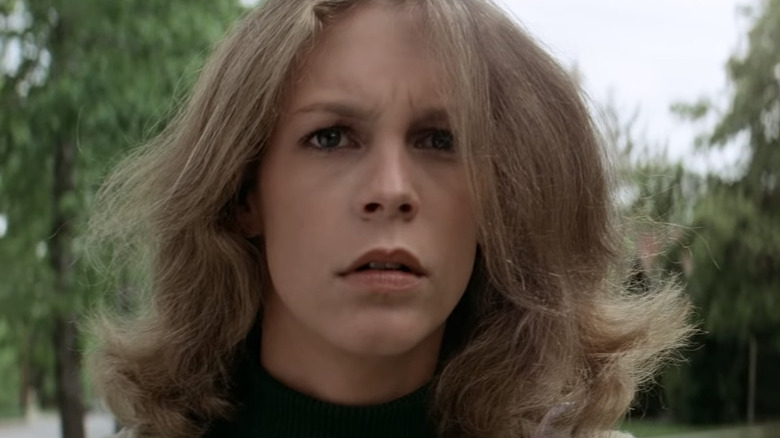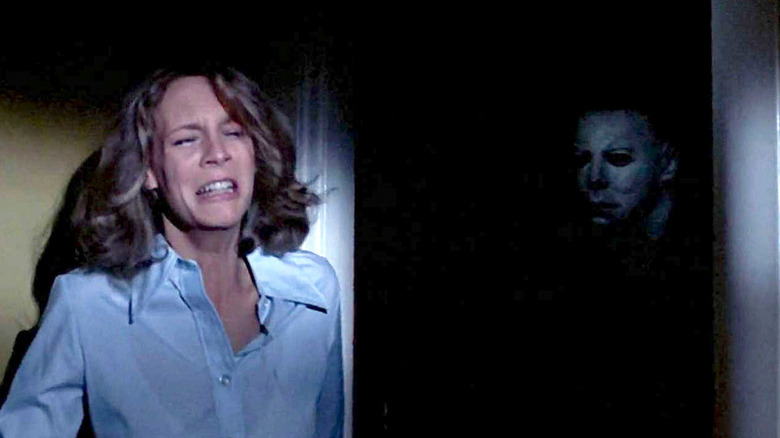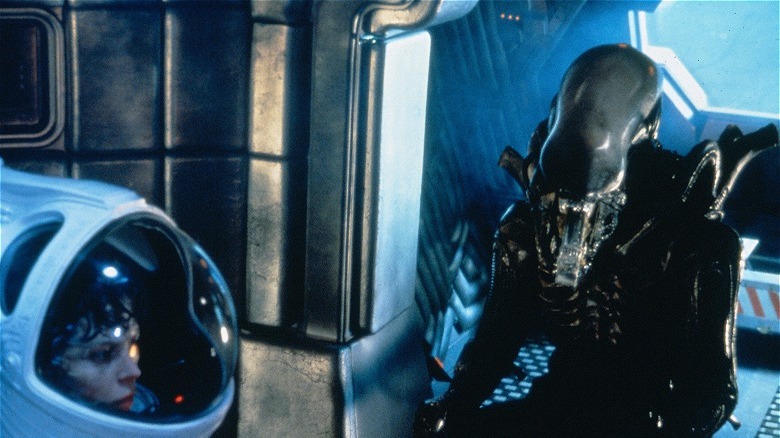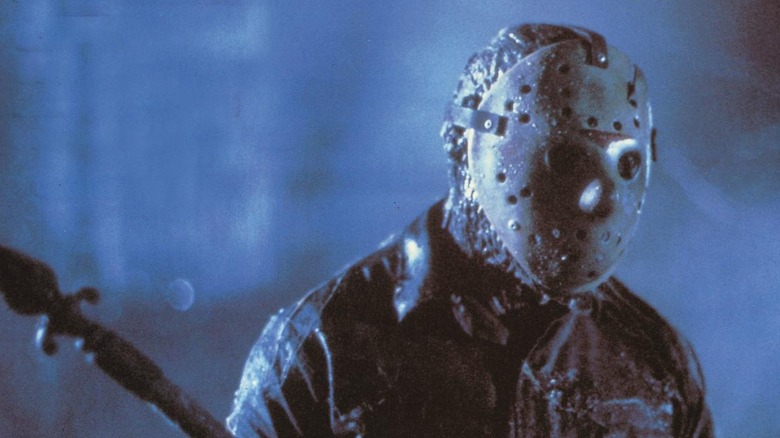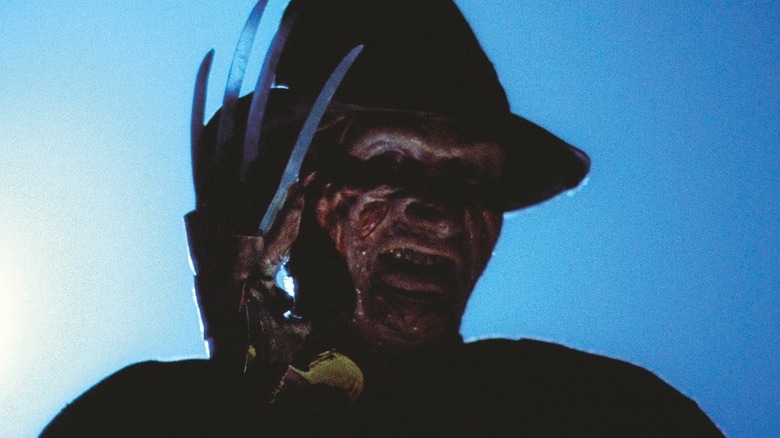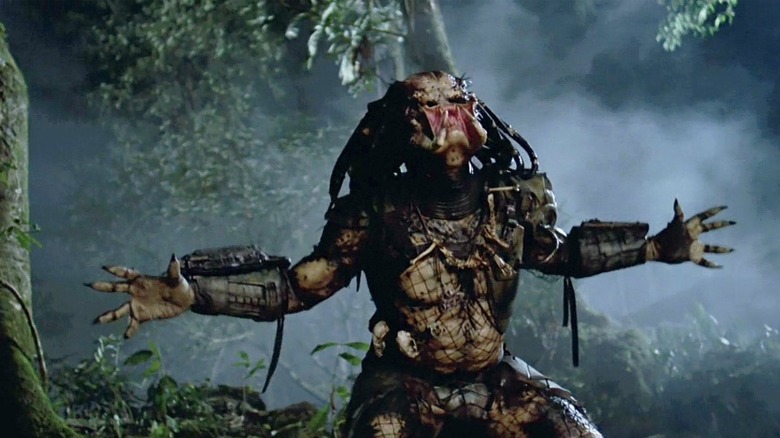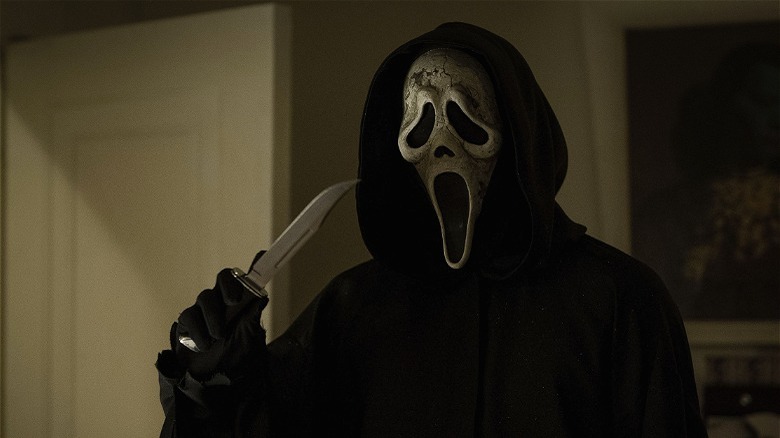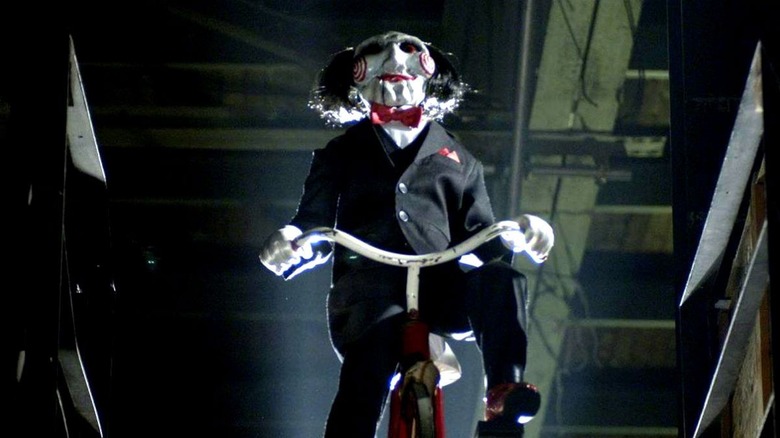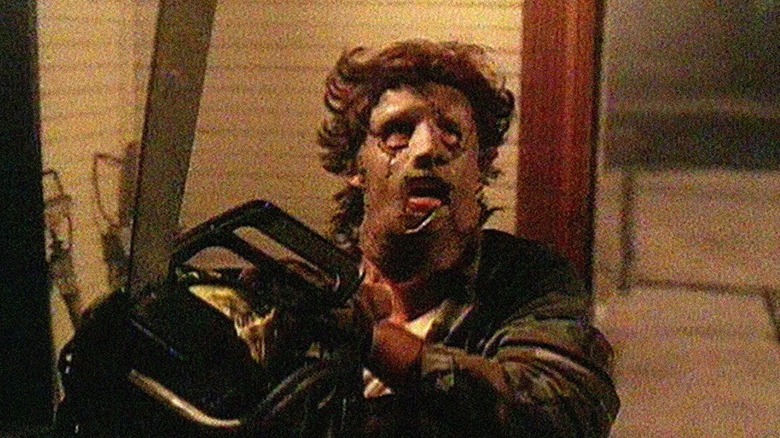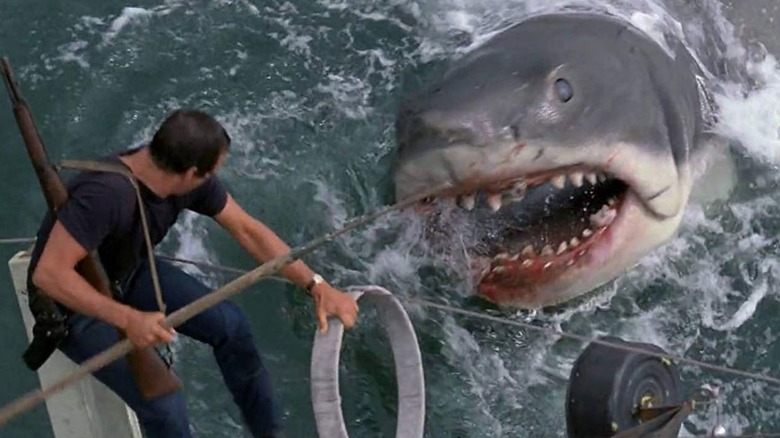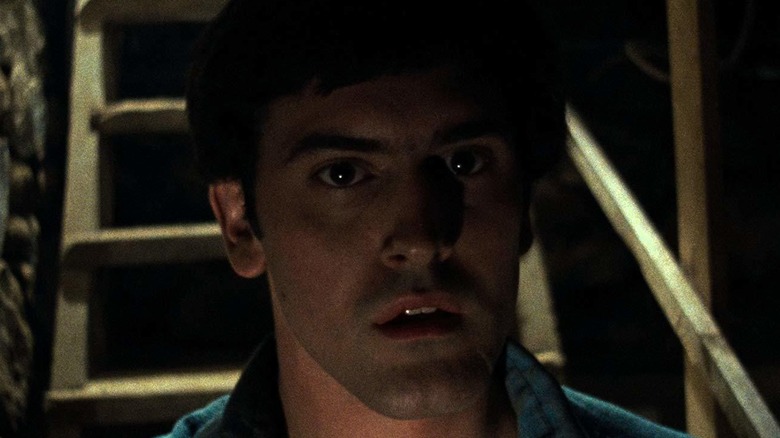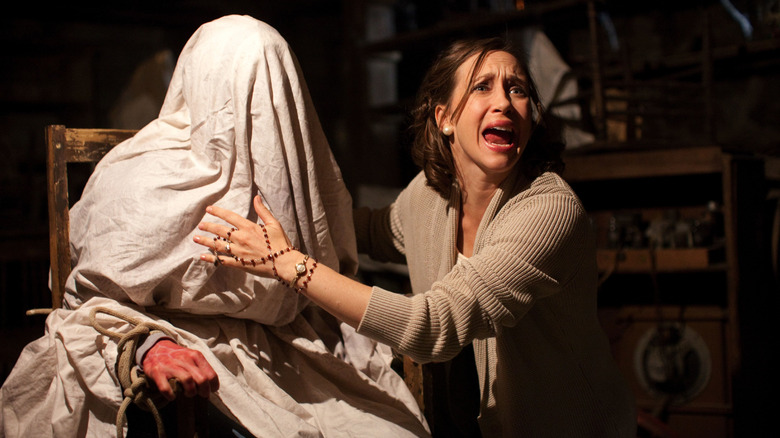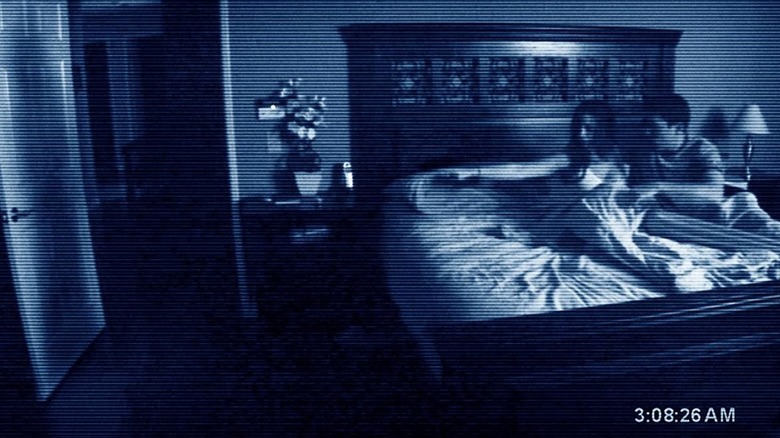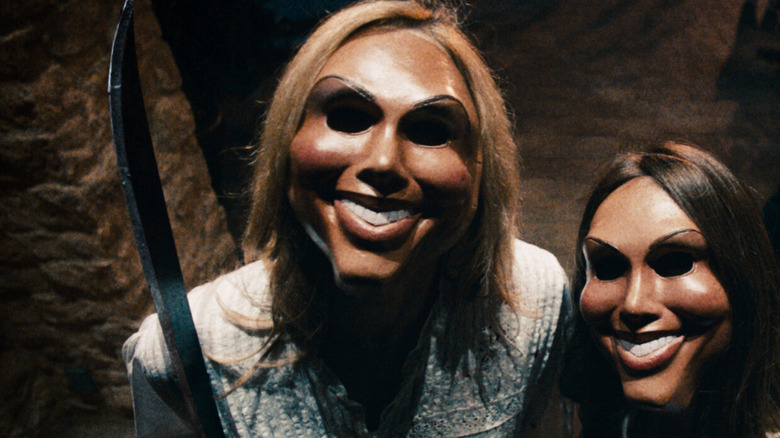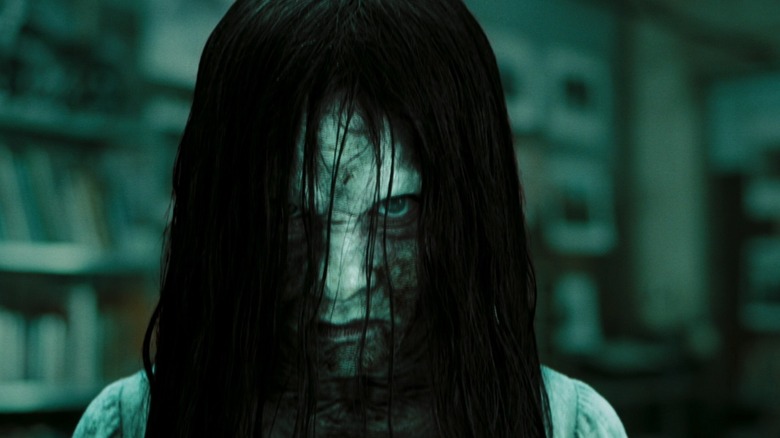The Biggest Blockbuster And Biggest Bomb In These Famous Horror Film Franchises
What do horror movie characters and Hollywood movie producers have in common? They're both unstoppable forces who pillage and plunder until something finally stops them. For horror movie characters, that something is a super-contrived death scene. For Hollywood movie producers, it's a box office bomb. But don't worry, because both will be back for the inevitable sequel, reboot, or remake! Horror movie producers are in the business of making money, since they're certainly not winning plaudits from critics or gold statues at award shows. Good thing horror movies are cheap to make, quick to produce, and usually a license to print cash ... until they aren't.
What kills horror movie characters aren't bullets, knives, getting set on fire or run over by trucks, but fan apathy. So while just about every horror film franchise has achieved great successes, most have also — eventually — suffered miserable failures. Some franchises take multiple decades and several Roman numerals to collapse, while others hit their expiration date after only a few installments. Whether the series runs three movies or 10 (and counting), let's take a look at the biggest blockbusters and bombs across some of your favorite horror film franchises.
Halloween
"Halloween" is the granddaddy of slasher horror. Sure, "Psycho" in 1960 came first, with its creepily charismatic killer, while 1974's "Black Christmas" and "The Texas Chainsaw Massacre" introduced many of the subgenre's tropes. However, "Halloween" in 1978 brought everything together into a formula that has been repeated ever since. "Halloween" not only kicked off the first true slasher horror series, but also one of the most fecund, with 12 sequels across 45 years. In fact, "Halloween" has effectively played out over five different timelines, making the DC Universe seem cogent. All of the franchise's highest-grossing hits share one common denominator: Jamie Lee Curtis' Laurie Strode.
When it comes to raw numbers David Gordon Green's 2018 soft reboot "Halloween" is numero uno, with $159 million domestic and $255 worldwide on a $10 million budget. Its insane profitability is unheard of today but pales in comparison to the 1978 original. On a $325,000 budget, "Halloween (1978)" grossed $47 million domestically and $79 million worldwide, roughly $354 million in today's dollars. While almost every "Halloween" movie made at least a slim profit, 1989's "Halloween 5: The Revenge of Michael Myers" took in a mere $11 million on a $6 million budget. Myers stayed dead for six years until 1995's "Halloween: Curse of Michael Myers." It actually performed a little better than "Halloween 5" ($15 million on a $5 million budget), but both movies were so abysmal they rebooted the series in 1998 with "H20" starring, you guessed it, Jamie Lee Curtis.
Alien
I would argue Ridley Scott's "Alien" (1979) is "'Halloween' in space." The differences are that "Alien" traded the psychotic serial killer for an ambivalently destructive xenomorph, and Jamie Lee Curtis' Laurie Strode for Sigourney Weaver's Lt. Ellen Ripley. But from a financial perspective, "Alien" rode the waves of other 1970s sci-fi mega-hits "Star Wars" and "Close Encounters of the Third Kind," with a gross that dwarfed what "Halloween" earned. "Alien" scared up $62 million domestically and $184 million worldwide on a $10 million budget in 1979, about $741 million in today's dollars. Strangely, it took 20th Century Fox seven years to make a sequel.
"Aliens" brought home $183 million on a $17 million budget, about $488 million today (and marks the rare instance in which a James Cameron movie didn't earn the most money). In 2012, Scott returned to the series with a prequel, "Prometheus." Its $402 million gross equates to $512 million today. Mighty impressive, but a far cry from the 1979 originals' franchise high-water mark. What about the busts? There really aren't any. The 2007 sequel "Aliens vs. Predator – Requiem" took in $128 million worldwide (roughly $180 million accounting for inflation) on a $40 million budget, which proved the xenomorphs did better at the box office on their own. I hope I'm wrong, but I'm betting that the upcoming "Alien: Romulus" — directed by Fede Alvarez and produced by Ridley Scott — will be the "Alien" series' biggest bust.
Friday the 13th
Jason Voorhees is one of the most unusual characters on this list. Technically, the main villain in "Friday the 13th" was his mom, but "killer mom gets vengeance for her son" doesn't scream franchise potential, so Jason became the big bad in the next 11 films. He's not just your everyday serial killer. Jason is effectively an immortal demon who has survived the depths of space and the bowels of hell. Hey, all in a day's work for a supernatural psychopath, right?
Believe it or not, in terms of pure profitability, Jason's mom is still the biggest draw. On a meager $550,000 budget, the 1980 original chopped up $59 million in box office grosses worldwide, roughly $209 million today. The rest of the series never reached those numbers, though there was a "Friday the 13th" movie released almost every year in the 1980s because they were such a safe bet. Sadly, that string of hits ended with 2002's "Jason X," which crashed and burned with $16 million worldwide on a $14 million budget. I guess "Jason Goes to Space" was a bridge too far for "Friday" fans. Jason's failure was short-lived, however, as the very next year "Freddy vs. Jason" earned $114 million worldwide. This was Jason's largest gross in raw numbers, though the $181 million inflation-adjusted numbers can't touch his mom's OG movie.
A Nightmare on Elm Street
You might be surprised to hear this, but Freddy Krueger never really hit the box office heights of his serial killer contemporaries, Michael Myers and Jason Voorhees. However, like a fine wine Freddy grew more popular with age ... until he went sour. Freddy's profitability was the kind that movie studios dream about (Get it? Because he kills people in their dreams?). Long before "The Lord of the Rings," New Line Cinema was "the house that Freddy built," which is why the studio released one nearly every year from 1984 to 1991.
Freddy's biggest box office hit was his bout against Jason Voorhees in 2003's "Freddy vs. Jason," which satiated decades of fan demand. Its $114 million worldwide would equal $181 million today. On his own, Freddy's number one movie is actually the 2010 "A Nightmare On Elm Street" remake; its $117 million worldwide would be $157 million today. Yep, turns out Jackie Earle Haley's Freddy out-earned Robert Englund's Krueger. Englund's biggest Freddy was "A Nightmare On Elm Street 4: The Dream Master," which raked in $49 million in 1988, or $121 million today. The series' lone misfire was "Wes Craven's New Nightmare," which put "Nightmare" to bed for nearly 10 years with $18 million on an $8 million budget. Moviegoers weren't ready for Craven making a meta-commentary on the slasher genre in 1994, but that would all change with 1996's "Scream."
Predator
I know what you're thinking: "Wait, is 'Predator' a horror, action, or sci-fi series?" If Blockbuster were still around (R.I.P.), you'd likely find it in the action section. However, the original has all the makings of a slasher horror film, except the baddie is an alien, not a serial killer, and the Final Girl is Arnold Schwarzenegger. The 1987 original was the creative high point for the series, but despite starring Ahh-nuld, it was not the highest-grossing film – adjusted or unadjusted for inflation. Still, nobody would complain about its $98 million worldwide gross on an $18 million budget, which technically makes "Predator" the most profitable flick in the franchise.
The top spot for the "Predator" franchise actually goes to 2004's "AVP: Alien vs. Predator." Its $172 million worldwide tops the list in raw numbers, while its $266 million inflation-adjusted gross means it probably sold the most tickets. So, sorry "Predator" fans, but it looks like "Alien" may be the more popular franchise. The "Predator" series also includes more high-profile duds, though it's a toss-up which "wins" (er, loses). "Predator 2" scored $54 million worldwide in 1992, or about $112 million adjusted, on a $35 million budget. Meanwhile, 2018's "The Predator" earned a frankly surprising $159 million worldwide in 2018 ... but that was offset by its ridiculously high $88 million budget. Let's just say when it comes to losing money, the "Predator" franchise does have time to bleed.
Scream
Wes Craven reinvented the slasher horror film not once, but twice. First, with his "A Nightmare on Elm Street" series, where the baddie Freddy Krueger killed victims in their sleep. The "Nightmare" series took a dirt nap after 1994's "Wes Craven's New Nightmare," which was ahead of its time. By "ahead of its time" I mean by like two years, as Craven brought back his brand of meta-commentary on the genre he helped create with 1996's "Scream." Whereas "Nightmare" operated in a supernatural world, "Scream" is a down-to-Earth slasher flick where everything could really happen. Well, maybe not David Arquette being a hero, but other than that, almost everything.
What made "Scream" fresh was that its characters were in on the act, having grown up watching slasher movies. Moviegoers dug it big time, as "Scream" earned $173 million worldwide, $322 million in today's dollars. This gross, made even more impressive by its $15 million budget, not only makes "Scream" the highest-grossing film in that franchise, but the biggest box office hit of Craven's career. So you could say Ghostface has a larger cultural impact than Freddy Krueger (you could, but I won't, because Freddy fans will cut you). "Scream" ran out of steam by "Scream 4," which earned $95 million worldwide on a $40 million budget. Fans may have been over "Scream" in 2011, but 2022's legacy sequel "Scream" brought the franchise back to its winning ways.
Saw
"Torture P***" was a thing in the 2000s, something I'm still trying to wrap my head around. Admittedly, part of slasher films' appeal is the outlandish death scenes. However, that was the exclusive appeal of torture p***. Before you accuse me of being an old man yelling at clouds (which I am, btw) I'll acknowledge one series that stood apart: "Saw." The "Saw" series helped launch "torture p****" and was insanely popular, spawning nine movies in less than two decades, and becoming an annual Halloween tradition from 2004-2010.
Even for people who don't like "torture p***," its storyline is iconic and helped establish Tobin Bell as a horror legend. Dying from an incurable disease, the central character Jigsaw (Bell) does what any normal, well-adjusted person would do, and forces innocent victims to play elaborate games to save their lives. With these pieces in place, "Saw" was basically a license to print cash. While almost all of them made a lot of money, the series hit its peak with "Saw III," which banked $163 million in 2006, or $236 million today. "Saw" quit while it was ahead with 2010's "Saw 3D," came back for 2017's successful legacy sequel, "Jigsaw," and then produced the franchise's lone bomb, "Spiral," in 2022. Starring and conceived by Chris Rock, this pseudo-sequel/spinoff didn't connect and probably confused audiences too. With $39 million worldwide on a $20 million budget, you could say "Saw" found itself between (Chris) Rock and a hard place.
Resident Evil
Ten movies in, "Resident Evil" is not only one of the most prolific horror franchises but the most prolific video game-based series. It's easy to see why. Long before "The Walking Dead" and "The Last of Us," the "Resident Evil" flicks satisfied audiences' bloodlust for post-apocalyptic zombie fare. While their budgets are usually two to three times the typical horror production, their grosses are almost across-the-board in the triple digits.
Ironically, the biggest blockbuster in the franchise was almost the biggest bomb, at least domestically. Wait, what? Yep, North American audiences were already over the series by 2017's "Resident Evil: The Final Chapter." It grossed $26 million domestically on a $40 million budget, an "L" for star Milla Jovovich. However, the movie also made $314 million worldwide, with $161 million of that coming from China, so it was also the franchise's highest-grossing flick worldwide. Crazy, right? The 2022 reboot "Resident Evil: Welcome to Raccoon City" was a franchise-killing bust by every objective measure. Sans Jovovich, the movie mustered a measly $17 million domestic and $41 million worldwide, though the $25 million budget was also the series' most economical, stopping the bloodbath at least a little bit.
The Texas Chainsaw Massacre
Despite being an OG slasher horror franchise, "The Texas Chainsaw Massacre" hasn't achieved the same box office success as the films that followed in its footsteps. Don't assume that it hasn't been profitable, as movie studios usually don't make eight sequels to underwhelming results. The 1974 original was the box-office champ for almost 30 years, despite only earning $26 million, or about $133 million in today's dollars. That's nothing to sneeze at, especially with a $140,000 budget.
However, the franchise's top dog -– both in unadjusted and adjusted numbers -– is the 2003 remake, which earned $107 million worldwide, or $155 million adjusted for inflation. I guess the combined might of Michael Bay producing and Jessica Biel playing the lead did the trick. However, star power didn't help the lowest-grossing film in the series, "Texas Chainsaw Massacre: The Next Generation." Even with Matthew McConaughey and Renée Zellweger in "before they were famous" roles, the 1995 film only earned $94,558 worldwide, or less than either of those A-listers probably rake in one day of work nowadays.
Jaws
You gain a much greater appreciation for Steven Spielberg's "Jaws" when you watch the films that followed. Spielberg's 1975 original is credited with kicking off the summer blockbuster season thanks to its $108 million domestic and $408 million worldwide gross, which equals about $2.2 billion (yes, with a "b") in inflation-adjusted dollars. The good vibes from that movie carried over to the 1978 sequel, "Jaws 2." Roy Scheider was back, but Spielberg was out, so there was a tremendous quality and financial drop-off. No worries. "Jaws 2" bit into $208 million worldwide, a steep plunge from the original, but still $933 million in today's dollars.
"Jaws 2" was able to ride the coattails on "Jaws," but that film's awfulness resulted in a massive decline for "Jaws 3-D" –- $42 million, or $123 million in today's dollars. "Jaws 3-D" made money, so someone — the producers? the studio? — figured why not keep churning out "Jaws" movies? Yeah, about that. "Jaws 4: The Revenge" finally tanked the series, earning $15 million worldwide (about $38 million in today's dollars) on a $23 million budget. So the "Jaws" franchise started with arguably the best summer movie ever and ended with one of the worst movies, period. You'll note they haven't produced any "Jaws" movies since 1987, so you might say the shark series is "fin"-ished.
The Evil Dead
"The Evil Dead" is a sui generis horror-comedy hybrid that defies easy categorization. While the "Evil Dead" boasts a rabid fanbase, it hasn't inspired the same diehard devotion among mainstream audiences. The series' most profitable film is the 1983 original, "The Evil Dead." Shot on a shoestring $375,000 budget by Sam Raimi, Bruce Campbell, and their buddies, "The Evil Dead" earned $29 million worldwide, or just over $86 million when adjusted for inflation. Surprisingly, the series' top cash cow is the 2013 Fede Alvarez-directed remake, "Evil Dead."
With a $17 million budget, it earned $99 million worldwide or $124 million adjusted. It only featured Ash (Campbell) in a post-credits cameo and nowhere in the marketing, suggesting moviegoers had little connection to the originals and saw "Evil Dead" merely as a horror movie. The franchise's biggest financial failure is debatable. Was it 1987's "Evil Dead II," which collapsed with $5.9 million on a $3.5 million budget? Or 1993's "Army of Darkness," which tanked with $21 million on an $11 million budget? Either way, the successes of the 1983 original and 2013 remake suggest mainstream audiences prefer "Evil Dead" when it's a straight horror series, not a horror-comedy hybrid. Further support for my thesis is that the Starz TV series "Ash vs. Evil Dead" — produced by Raimi and starring Campbell — was canned after three seasons due to declining ratings. I'm saying this as a hardcore "Evil Dead" stan, but the numbers don't lie.
The Conjuring
Horror movies are known for their profitability, but "The Conjuring" franchise puts up blockbuster numbers. There's a reason they have made nine movies and counting in 10 years; with $2.1 billion worldwide, "The Conjuring" has a per-film average of $263 million. For context, that puts "The Conjuring" series between "Minions" and "Planet of the Apes" for total box office among franchises. Interestingly, the series' number one hit is the 2018 spinoff, "The Nun," which conjured up $363 million worldwide, $423 million adjusted, on a $22 million budget.
Which is the series' worst bomb? None of them. "The Conjuring" hasn't produced a dud ( ... yet), so expect the franchise to remain an "every other year" tradition until that changes. However, for what it's worth, the spinoff "The Curse of La Llorona" only collected $123 million worldwide in 2019, while "The Conjuring: The Devil Made Me Do It" raked in $200 million in 2021. With its $40 million budget, "The Devil Made Me Do It" was still profitable, but brought home $100+ million less than "The Conjuring 2: The Enfield Poltergeist."
Paranormal Activity
"Found footage" movies may be mostly associated with "The Blair Witch Project" or "Cloverfield," but the clear winner when it comes to box office results is the "Paranormal Activity" series. Seriously, it's hard to scale just how successful these films have been. The highest-grossing is 2011's "Paranormal Activity 3," which made $207 million ($269 million adjusted for inflation) on a $5 million budget. But in terms of pure profitability, the ghost with the most isn't even close.
"Paranormal Activity" cost a mere $450,000 to produce, but spirited away with a staggering $194 million worldwide in 2009, for an inflation-adjusted gross of $264 million. With nearly $200 million on a less than half-a-million-dollar budget, "Paranormal Activity" is the most profitable movie of all time. Despite cranking out seven movies in 12 years, Blumhouse Productions hit the "pause" button with 2015's "Paranormal Activity: The Ghost Dimension." On a $10 million budget, the movie made $77 million worldwide, but only $18 million domestically, signaling audience disinterest and diminishing returns. In 2021, "Paranormal Activity: Next of Kin" didn't even get a theatrical release, but haunted Paramount+ instead.
The Purge
"The Purge" franchise envisions a dystopian future that's not much different from ours, except once a year all crime is legal for 12 hours. Given that this is a horror franchise, people don't use this 12-hour window to steal movie tickets or jaywalk, but rather to sexually assault, pillage, plunder, and murder. "The Purge" doesn't inspire much confidence about the human race, but it has been a big hit with moviegoers.
The first "Purge" earned $91 million in 2013 and the series saw mostly steady increases with each entry. Film four in the franchise -– 2018's "The First Purge" -– banked the most of any "Purge" movie, though its $13 million budget was quadruple the original's $3 million. Somehow, I doubt Blumhouse Productions worried about that. They were surely concerned about the precipitous decline of the fifth (and so far last) film, "The Forever Purge." Released in 2021, "The Forever Purge" cost $18 million to produce, but collected only $76 million worldwide, a steep 45% decline despite having the series' highest budget. With its lukewarm response, perhaps audiences have purged themselves of "The Purge." And we didn't even mention "The Purge" television series that ran for two seasons between 2018 and 2019.
The Ring
Japanese horror remakes were big business in the 2000s, and none were more massive than "The Ring." Released in 2002, "The Ring" made stars out of Naomi Watts and director Gore Verbinski, and it banked a lot of money. Even with a pricey (for horror) $48 million budget, "The Ring" earned $248 million worldwide in 2002, which is about $403 million today. Naturally, Dreamworks put out a sequel, though fan enthusiasm seemed to have dwindled during the three-year gap.
"The Ring Two" cost $50 million to produce and netted $161 million at the worldwide box office ($241 million adjusted for inflation), great numbers, but a 36% decline from the original. "The Ring" franchise took a 12-year break, going the legacy sequel route for 2017's "Rings." The movie was wisely produced for a modest $25 million budget, about half of the previous two entries before inflation, and earned $82 million worldwide. Those numbers meant "Rings" was probably profitable, but its domestic gross of $27 million was pitiful. The tagline for the original was "before you die you see the ring," but clearly moviegoers weren't dying to go back to this franchise. "The Ring" was a major movie in the early aughts, but it appears that's where it should stay.
